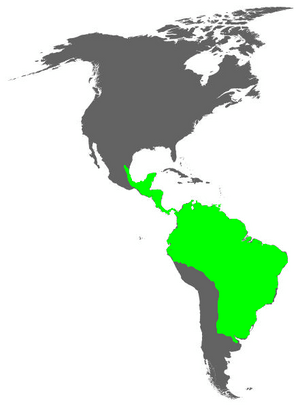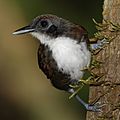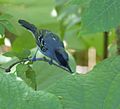Antbird facts for kids
Quick facts for kids Antbirds |
|
|---|---|
 |
|
| The barred antshrike has a wide range. Its hooked bill is typical of the antshrikes | |
| Scientific classification | |
| Kingdom: | |
| Class: | |
| Order: | |
| Suborder: | |
| Family: |
Thamnophilidae
|
| Diversity | |
| Some 45 genera, over 200 species | |
 |
|
| Global range (in green) | |
Antbirds are a big family of birds called Thamnophilidae. You can find them in warm, wet places in Central America and South America, from Mexico all the way down to Argentina. There are over 200 different kinds of antbirds! Some are called antshrikes, antwrens, antvireos, fire-eyes, bare-eyes, and bushbirds.
They are related to other bird families like antthrushes and antpittas. Even though some antbirds have names like 'wren' or 'shrike', they are not actually close relatives of those birds.
Contents
About Antbirds
Antbirds are usually small birds. They have rounded wings and strong legs. Their feathers are often dull colors like grey, white, brown, or reddish-brown. Male and female antbirds often look a bit different in their patterns and colors. Some species show off white patches of feathers on their backs or shoulders to warn other birds. Most antbirds have strong beaks, and many have a hooked tip.
Where Antbirds Live
Most antbirds live in forests. A few species can be found in other places too. They mostly eat insects and other small creatures like spiders. Sometimes, they might eat small vertebrates (animals with backbones). Most antbirds look for food in the lower and middle parts of the forest. Some feed high up in the trees, and a few search for food on the ground.
Antbirds and Army Ants
About eighteen types of antbirds are special because they follow groups of army ants. These ants march in huge columns. As they move, they scare out small insects and other tiny animals. The antbirds then swoop in to eat these creatures that are trying to escape the ants.
Antbird Families
Antbirds are monogamous, which means they mate for life. They also protect their own territories. Antbirds usually lay two eggs in their nests. Both parents work together to incubate (keep warm) the eggs. They also both help raise the baby birds, called nestlings. After the young birds are old enough to fly (fledge), each parent takes care of one chick.
Protecting Antbirds
Sadly, thirty-eight species of antbirds are in danger of disappearing. This is mostly because of human activities. The biggest problem is habitat loss, which means their forest homes are being destroyed. When their homes are gone, it's easier for predators to find their nests.
Images for kids
-
The legs and feet of ant-following antbirds are stable and adapted to gripping vertical stems and branches. The leg muscles of the bicoloured antbird make up 13 % of the total body weight.
-
Ochre-rumped antbird calling
-
The barred antshrike is distributed from Mexico to Argentina. It has the hooked bill typical of the antshrikes.
-
A variable antshrike gleaning insects from foliage
-
The black-hooded antshrike is a relatively sluggish species usually found singly or in pairs. Here a male feeds on a caterpillar.
-
Immaculate antbirds regularly attend army ant swarms in order to feed, but they are not obligate ant-followers; they also forage away from the swarms.
-
The ocellated antbird has an unusual social system of shared breeding territories. One dominant pair may share a territory with up to six other birds.
-
A female variable antshrike constructing a nest
-
The pectoral antwren of Brazil is threatened by the loss of deciduous forest and is listed as vulnerable by the IUCN.
See also
 In Spanish: Tamnofílidos para niños
In Spanish: Tamnofílidos para niños










